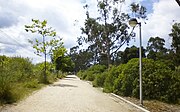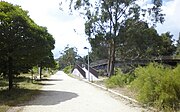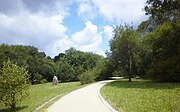
Pontevedra is a city in the autonomous community of Galicia, in northwestern Spain. It is the capital of both the Comarca and Province of Pontevedra, and the capital of the Rías Baixas. It is also the capital of its own municipality which is often considered an extension of the actual city.

The Covo Island, better known as the Island of Sculptures or Illa das Esculturas in Galician, is a park and island located near the mouth of the Lérez River, in Pontevedra, Spain. It has an area of 70,000 m² and is connected to both banks of the river by footbridges and pedestrian bridges. It is the largest and most important open-air museum in Galicia and one of the most important in Spain.

The Pontevedra Auditorium and Convention Centre is a building that hosts conventions, exhibitions, concerts, plays and ballet and dance performances in Pontevedra (Spain). It is located in the northern part of the city, next to the Lérez river and the Tirantes bridge and was designed by the architect Manuel de las Casas.

The Palm Trees Park, also known simply as Las Palmeras, is a public park in the heart of Pontevedra in Spain. It is the most representative and emblematic green area in the city centre, together with the Alameda de Pontevedra.

The Lérez beach is a Galician beach located in the municipality of Pontevedra in the province of Pontevedra, Spain. It is a semi-urban river beach with a length of 100 metres.

The Pontevedra campus is one of three campuses that host the University of Vigo. It is located in the Spanish city of Pontevedra and offers undergraduate, postgraduate and doctoral studies in Social sciences, health sciences, arts, engineering and Sports.

Campolongo is a neighbourhood in the city of Pontevedra (Spain). It has a residential, administrative, educational and commercial function.

Monte Porreiro is a residential area in the city of Pontevedra (Spain). It is the seat of the National University of Distance Education in the province of Pontevedra. The neighbourhood has a health centre, a school and a high school and a parish church since the end of the 20th century, its patron saint being the Good Shepherd. There are also green areas, the most important being the Belvedere Park.
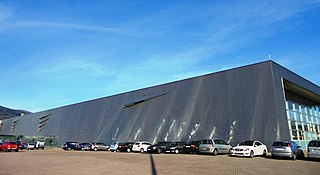
The Pontevedra Exhibition Centre is a complex for events such as exhibitions, fairs and conventions. It is in the Rosalía de Castro Park, near the banks of the Lérez River in Pontevedra, Galicia (Spain).

The Botanical Garden of Lourizán is an arboretum of some 54 hectares in the municipality of Pontevedra in Spain. It has more than 850 catalogued species and one of the largest collections in Spain. It is the most important botanical garden in Galicia.
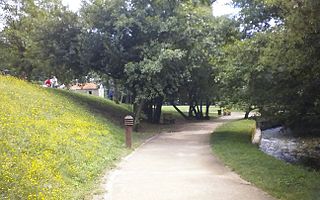
The Gafos Park is a public park located in Pontevedra, Spain. It is a linear park surrounding the Gafos River, which runs through the south of the city from east to west.
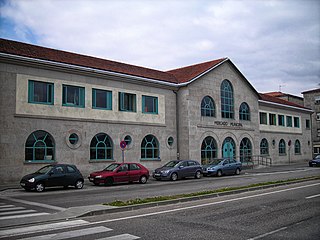
The Central Market of Pontevedra is a covered market located in Pontevedra, Spain. It is located at the north-eastern edge of the historic centre, close to the Burgo Bridge. It overlooks the banks of the Lérez river and was inaugurated in 1948.

The Administrative building of the Xunta de Galicia in Pontevedra is an office complex designed to house the various public services of the Galician Government in Pontevedra, Spain. The building houses many of the Galician administration's departments and was designed by the architects Manuel Gallego Jorreto and Jacobo Rodríguez-Losada Allende.

The paseo marítimo of Pontevedra is a pedestrian way along the seafront facing the ria of Pontevedra, in Pontevedra, Spain. This coastal public space is built in the urban and semi-urban area of the city and defines its encounter with the sea and the Lérez river.

O Burgo is a neighbourhood in the city of Pontevedra (Spain). It is one of the oldest neighbourhoods in the city and is crossed by the Portuguese Way. On its right-hand side is the A Xunqueira area with important educational and cultural facilities.

A Parda is a neighbourhood located in the eastern part of the city of Pontevedra (Spain). It has a mainly residential function and also has important judicial, educational and health facilities.

The Forest Engineering School of Pontevedra is a university school founded in 1990 in the Spanish city of Pontevedra, based on the campus of A Xunqueira, in the north of the city.

The Faculty of Management and Public Administration of Pontevedra is a university faculty founded in 2022 in the Spanish city of Pontevedra, based on the campus of A Xunqueira, in the north of the city.
The School of Forestry Engineering of Pontevedra is a university center founded in 1990 in the Spanish city of Pontevedra and based in the campus of A Xunqueira, in the north of the city.

Belvedere Park is a public park in the Monte Porreiro neighbourhood of the Spanish city of Pontevedra.




